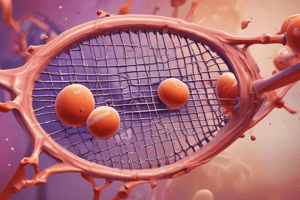Podcast
Questions and Answers
Which of the following characteristics describes Rickettsial infections?
Which of the following characteristics describes Rickettsial infections?
- Transmitted primarily through respiratory droplets
- Motile and spore-forming
- Cultivable in artificial media
- Gram-negative and obligate intracellular (correct)
What is the primary method of transmission for Rickettsial infections?
What is the primary method of transmission for Rickettsial infections?
- Airborne particles from coughing and sneezing
- Arthropod vectors like ticks and fleas (correct)
- Contaminated food and water
- Direct contact with infected individuals
Which of the following is NOT a characteristic of the Rickettsia genus?
Which of the following is NOT a characteristic of the Rickettsia genus?
- Gram-negative cell wall
- Multiplies by binary fission
- Cultivated on artificial media (correct)
- Contains both DNA and RNA
Which disease is NOT classified within the Rickettsial infections?
Which disease is NOT classified within the Rickettsial infections?
Which type of antigens are species-specific and highly immunogenic for Rickettsia?
Which type of antigens are species-specific and highly immunogenic for Rickettsia?
What is the primary vector for epidemic typhus?
What is the primary vector for epidemic typhus?
Which of the following is NOT a clinical manifestation of epidemic typhus?
Which of the following is NOT a clinical manifestation of epidemic typhus?
What is a significant complication associated with epidemic typhus?
What is a significant complication associated with epidemic typhus?
What is the primary reservoir for endemic typhus?
What is the primary reservoir for endemic typhus?
Which mode of transmission is common for both epidemic and endemic typhus?
Which mode of transmission is common for both epidemic and endemic typhus?
How does Rocky Mountain spotted fever primarily present in terms of rash?
How does Rocky Mountain spotted fever primarily present in terms of rash?
What laboratory method is considered specific for diagnosing rickettsial infections?
What laboratory method is considered specific for diagnosing rickettsial infections?
Which sign is characteristic of Indian tick typhus?
Which sign is characteristic of Indian tick typhus?
Flashcards are hidden until you start studying
Study Notes
General Properties
- Rickettsia are non-motile, gram-negative, coccobacilli.
- They are obligate intracellular bacteria, meaning they must live inside host cells.
- Rickettsia cannot be grown in artificial media.
- They are transmitted by arthropod vectors, such as ticks, mites, and fleas.
- Rickettsia infect vascular endothelial cells.
Classification
- Rickettsia belong to the order Rickettsiales, and are further classified into two families: Rickettsiaceae and Anaplasmataceae.
- Genera within these families include Rickettsia, Orientia, Ehrlichia, Wolbachia, Anaplasma, and Neorickettsia.
- Coxiella and Bartonella were previously in the Rickettsiaceae family, but are no longer considered to be obligate intracellular bacteria and are not transmitted by arthropods.
Rickettsia VS Virus
- Rickettsia possess a gram-negative cell wall.
- They contain both DNA and RNA.
- Rickettsia multiply through binary fission.
- They can be killed by antimicrobial agents.
- Rickettsia are visible under a light microscope.
- They cannot pass through bacterial filters.
- These characteristics distinguish them from viruses.
Rickettsia Infection
- Rickettsiae cause a group of diseases known as typhus or spotted fever.
- Typhus group:
- Spotted fever:
- R. akari (Rickettsialpox)
- R. rickettsii (Rocky Mountain Spotted Fever)
- R. conorii (Mediterranean spotted fever)
- R. africae (African tick-bite fever)
- Typhus:
- R. prowazekii (Epidemic typhus)
- R. typhi (Endemic typhus)
- Spotted fever:
- Antigenic structures of Rickettsia:
- OMP antigens: Species-specific and highly immunogenic.
- LPS antigens: Group-specific and used in the Weil-Felix reaction.
Pathogenesis
- Reservoirs:
- Ticks and mites
- Lice and fleas
- Transmission:
- Through the bite of an arthropod
- Rubbing or scratching an abraded surface contaminated with rickettsia
- Spread in the body:
- Through the lymphatics, where they multiply in lymph nodes.
- They then enter the bloodstream and eventually reach endothelial cells.
- Endothelial cell infection:
- Rickettsia adhere to endothelial cells using OmpA and OmpB proteins.
- They are phagocytosed by endothelial cells and multiply by binary fission within the cell.
- Cell lysis occurs, except in spotted fever.
Diseases Caused by Rickettsia
-
Endemic Typhus (Flea-borne)
- Vector: Rat flea (R. typhi)
- Reservoir: Rodents
- Mode of transmission: Similar to epidemic typhus
- Clinical manifestation: Similar to epidemic typhus, but less severe.
-
Epidemic Typhus
- Vector: Human body louse (P. humanus capitis)
- Transmission: Rubbing or scratching of abraded skin, ingestion of feces contaminated with rickettsia, rarely inhalation.
- Clinical manifestation: Acute febrile disease with headache, muscle and joint pain, rash (beginning on the upper trunk and spreading to the entire body), myalgia.
- Complications: Intestinal pneumonitis, CNS involvement (mental confusion, coma).
- Risk factors: High louse population, poor hygiene.
- Brill-Zinsser disease: Reactivation of epidemic typhus due to waning immunity.
-
Rocky Mountain Spotted Fever
- Vector: Ticks
- Clinical manifestation: Fever, headache, rash (on extremities and trunk), myalgia, anorexia.
- Complications:
- Vascular damage (permeability, edema, hemorrhage, DIC).
- Interstitial pneumonitis.
- CNS involvement.
-
Indian Tick Typhus
- Vector: Tick (Rhipicephalus sanguineus)
- Clinical manifestation: Similar to RMSF.
- An eschar (a necrotic lesion) is present at the site of the tick bite.
Laboratory Diagnosis
- Serology:
- Antibody detection:
- Non-specific (Weil-Felix test): Less sensitive and specific, but inexpensive.
- Specific (IFA/ELISA): More sensitive and specific.
- The Weil-Felix test relies on the presence of LPS antigen of rickettsia in Proteus species.
- Antibody detection:
Studying That Suits You
Use AI to generate personalized quizzes and flashcards to suit your learning preferences.




